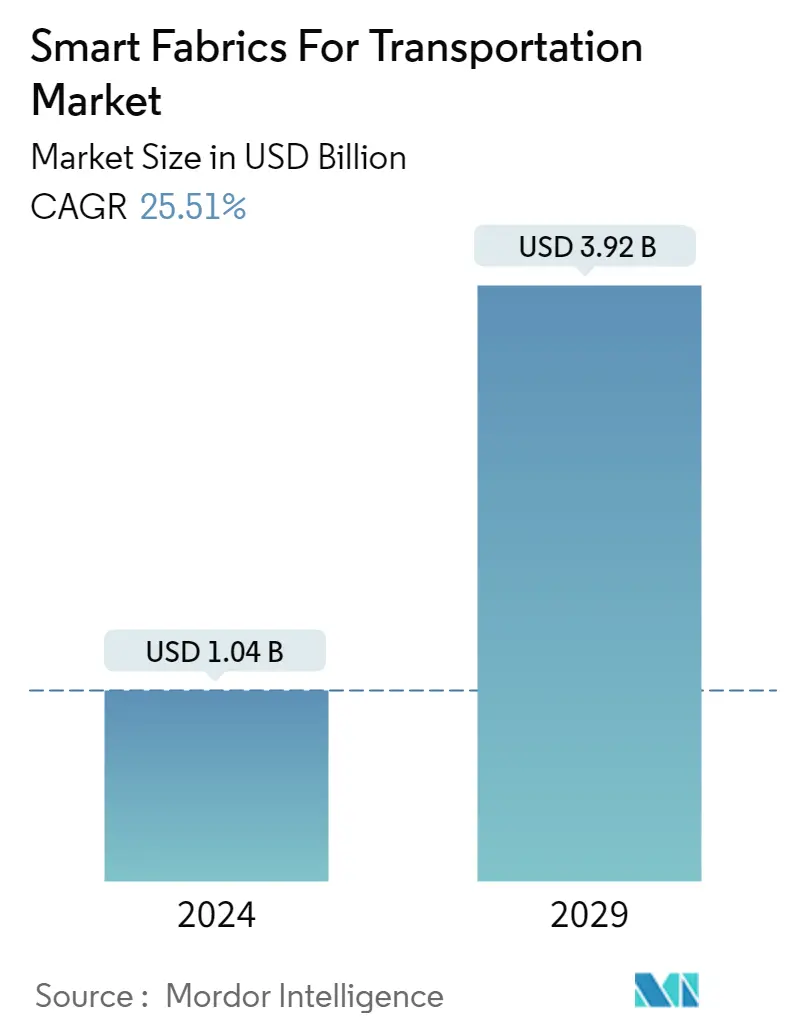Market Size of Smart Fabrics For Transportation Industry

| Study Period | 2019 - 2029 |
| Market Size (2024) | USD 1.04 Billion |
| Market Size (2029) | USD 3.92 Billion |
| CAGR (2024 - 2029) | 25.51 % |
| Fastest Growing Market | Asia Pacific |
| Largest Market | North America |
Major Players
*Disclaimer: Major Players sorted in no particular order |
Smart Fabrics for Transportation Market Analysis
The Smart Fabrics For Transportation Market size is estimated at USD 1.04 billion in 2024, and is expected to reach USD 3.92 billion by 2029, growing at a CAGR of 25.51% during the forecast period (2024-2029).
- The electronics industry's drastic technological advancement has changed how people do and perceive things. The Internet of Things has connected everything. Smart fabrics are a crucial part of this technological advancement, playing a significant role in the future, with applications in the transportation industry.
- The miniaturization of various electronic components and the emergence of various advanced polymers are driving the market forward. Also, with the development of fabrics with antistatic properties, tremendous stain-proof capabilities and the overall ability of fabrics to interact with the environment, which further helps regulate temperature, are offered. These critical properties of smart fabrics have enabled their use in automotive vehicles.
- Moreover, the use of fabrics in automobiles is not only restricted to upholstery, but they are also widely used in floor mats, seat belt webbings, the interior ceiling, steering wheel, interior door panels, and gear shift covers. Additionally, fabrics are not only meant for the exterior surfaces, which are visible but are also used in the preparation of insulation for thermal control inside the vehicle. The versatile nature of the fabrics has made them a crucial component of automobiles, driving the market forward.
- The increasing adoption of bluetooth low energy (BLE) technology and miniaturization of electronic components is a crucial driver for the smart fabrics for transportation market growth. The BLE technology-enabled garments can sense and monitor data when connected to the Internet. There has been a rising trend of miniaturization of electronic components and systems, which has expedited the need for smaller assembly components for manufacturing smart fabrics. Radical developments in wireless and electronic technologies have enabled miniaturization and their integration into conductive textiles, which is expected to fuel the market growth during the forecast period.
- However, factors like slow penetration rate in developing countries, as well as lack of funding and capital expenditure, could be a matter of concern that could limit the market's overall growth throughout the forecast period.
Smart Fabrics for Transportation Industry Segmentation
Smart fabrics are defined as textiles that can sense and react to external environmental conditions or stimuli from thermal, mechanical, chemical, magnetic, electrical, or other sources. They are able to respond and sense external conditions (stimuli) in a predetermined way.
The smart fabrics for transportation market is segmented by component (automobile interior carpets, automotive airbags, seat belt webbings, heated seats, and nylon tire cord fabrics), material (color-changing material, light-emitting materials, moving materials, and temperature changing material), application (mobility management, vehicle management, safety and security, and passenger information system), end-user industry (automobiles, shipping, railways, and aerospace), and geography (North America, Europe, Asia-Pacific, Latin America, and Middle East & Africa).
The market sizes and forecasts are provided in terms of value (USD) for all the above segments.
| By Component | |
| Automobile Interior Carpets | |
| Automotive Airbags | |
| Seat Belt Webbings | |
| Heated Seats | |
| Nylon Tire Cord Fabrics |
| By Material | |
| Color Changing Material (Photo Chromic Material and Thermo Chromic Material) | |
| Light Emitting Materials (Electroluminescent Materials, Fluorescent Material, Phosphorescent Material, and Light Emitting Diodes (LED)) | |
| Moving Materials (Conducting Polymers, Piezoelectric Material, Polymer Gel, and Shape Memory Alloys (SMA)) | |
| Temperature Changing Material (Thermoelectric material) |
| By Application | |
| Mobility Management | |
| Vehicle Management | |
| Safety and Security | |
| Passenger Information System |
| By End-user Industry | |
| Automobiles | |
| Shipping | |
| Railways | |
| Aerospace |
| Geography*** | |
| North America | |
| Europe | |
| Asia | |
| Latin America | |
| Middle East and Africa |
Smart Fabrics For Transportation Market Size Summary
The smart fabrics for transportation market is poised for significant growth, driven by advancements in electronics and the Internet of Things. These fabrics are becoming integral to the transportation industry, offering features like temperature regulation, stain resistance, and environmental interaction. Their application extends beyond traditional uses in upholstery to include components such as floor mats, seat belts, and insulation, enhancing vehicle functionality and efficiency. The market is further propelled by the adoption of Bluetooth Low Energy technology and the miniaturization of electronic components, enabling the integration of smart fabrics into vehicles. Despite challenges like slow adoption in developing regions and funding constraints, the market is expected to expand as autonomous and electric vehicles gain traction.
North America holds a dominant position in the smart fabrics for transportation market, fueled by technological advancements and increasing demand from sectors like automotive and aerospace. The region's focus on IoT integration and the rise of autonomous vehicles create ample opportunities for market growth. Key players in the region are launching advanced products, leveraging IoT to enhance operational processes in transportation. The competitive landscape is characterized by moderate concentration, with companies like Kolon Glotech Inc. and AIQ Smart Clothing Inc. leading through innovation. Recent developments, such as ThermoSiv's eco-friendly smart fabric and Apple's integration of smart fabrics with lighting systems, highlight the ongoing innovation and potential for sustainable solutions in the industry.
Smart Fabrics For Transportation Market Size - Table of Contents
-
1. MARKET DYNAMICS
-
1.1 Market Overview
-
1.2 Introduction to Market Drivers and Restraints
-
1.3 Market Drivers
-
1.3.1 Increasing Number of Connected Cars and Heavy Vehicles
-
1.3.2 Miniaturization of Electronic Components
-
1.3.3 Increasing Safety and Security Concerns in Transportation
-
-
1.4 Market Restraints
-
1.4.1 Slow Penetration Rate in Developing Countries
-
1.4.2 Lack of Funding and Capital Expenditure
-
-
1.5 Industry Attractiveness - Porter's Five Forces Analysis
-
1.5.1 Threat of New Entrants
-
1.5.2 Bargaining Power of Buyers/Consumers
-
1.5.3 Bargaining Power of Suppliers
-
1.5.4 Threat of Substitute Products
-
1.5.5 Intensity of Competitive Rivalry
-
-
-
2. MARKET SEGMENTATION
-
2.1 By Component
-
2.1.1 Automobile Interior Carpets
-
2.1.2 Automotive Airbags
-
2.1.3 Seat Belt Webbings
-
2.1.4 Heated Seats
-
2.1.5 Nylon Tire Cord Fabrics
-
-
2.2 By Material
-
2.2.1 Color Changing Material (Photo Chromic Material and Thermo Chromic Material)
-
2.2.2 Light Emitting Materials (Electroluminescent Materials, Fluorescent Material, Phosphorescent Material, and Light Emitting Diodes (LED))
-
2.2.3 Moving Materials (Conducting Polymers, Piezoelectric Material, Polymer Gel, and Shape Memory Alloys (SMA))
-
2.2.4 Temperature Changing Material (Thermoelectric material)
-
-
2.3 By Application
-
2.3.1 Mobility Management
-
2.3.2 Vehicle Management
-
2.3.3 Safety and Security
-
2.3.4 Passenger Information System
-
-
2.4 By End-user Industry
-
2.4.1 Automobiles
-
2.4.2 Shipping
-
2.4.3 Railways
-
2.4.4 Aerospace
-
-
2.5 Geography***
-
2.5.1 North America
-
2.5.2 Europe
-
2.5.3 Asia
-
2.5.4 Latin America
-
2.5.5 Middle East and Africa
-
-
Smart Fabrics For Transportation Market Size FAQs
How big is the Smart Fabrics For Transportation Market?
The Smart Fabrics For Transportation Market size is expected to reach USD 1.04 billion in 2024 and grow at a CAGR of 25.51% to reach USD 3.92 billion by 2029.
What is the current Smart Fabrics For Transportation Market size?
In 2024, the Smart Fabrics For Transportation Market size is expected to reach USD 1.04 billion.

